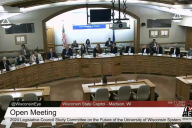You have /5 articles left.
Sign up for a free account or log in.
Many of you may be familiar with threshold concepts. It’s a model for disciplinary learning proposed by Erik Meyer and Ray Land in 2003 that describes the process by which students enter into a field of study.
The key for Meyer and Land is adopting threshold concepts that trouble previously held ways of looking at that discipline or in some cases the world around us.
Threshold concepts require a change of thinking.
They’re conceptually difficult, counterintuitive or, in Meyer and Land’s terms, troublesome.
Meyer and Land suggest there are different kinds of troublesome knowledge: ritual, inert, conceptually difficult, alien and tacit.
Do these categories align with the troublesome knowledge that you encounter and share every day in learning innovation?
These are not the core concepts of a particular field, though they help to give definition to the field. They force us to see things differently about the field of study, and once we have, it’s difficult if not impossible to go back. To understand a threshold concept means spending time and passing through that liminal space between being a novice and moving toward becoming an expert.
When Eddie entered into English literature, structuralism (and poststructuralism), with a foundation in Saussurean linguistics, was such a threshold concept. It changed the way he understood the role of language (and by extension of literature) in shaping culture and knowledge. For him, (post)structuralism was also integrative (another key aspect of threshold concepts), bringing together many theoretical frameworks and methods to try to understand a complex system of knowledge, representation and power.
For Josh, an example of a foundational threshold concept in his graduate training in population science is demographic transition theory. This theory of modernization holds that societies evolve from regimes of high fertility and high mortality to low mortality and low fertility as they develop. How demographic transition theory helps us understand the causes and consequences of below replacement fertility, when the total fertility rate drops well below 2.1 (as in Japan's 1.4), has been an animating question for Josh throughout his academic career.
We’ve been arguing that learning innovation, as we’re calling it, may be developing the contours of an interdisciplinary field. A field we should push on and prod and potentially nurture into some shape.
The field, as we see it, brings together design theory, learning science, educational technology, learning analytics and organizational change, all integrated by the common thread of critical studies in higher education.
We’re arguing that these fields, when brought together, are different than when studied alone. We think they are even more unique when studied within the context of higher education.
This is, for us, a threshold concept of the field.
One of the key aspects of threshold concepts is that they are integrative. The fields many of us study individually, taken together, form something unique and force us to see our work differently.
But we’re still pushing on this argument, and one way to explore it is to think about the threshold concepts that define the field.
For instance, one of the central questions that we believe requires scholarly attention is to unpack and understand the conditions in which institutions align teaching practices with learning science.
What factors promote or inhibit universities from building classrooms designed around active learning principles -- such as flat floors with movable furniture and flexible technology to support group work -- as opposed to tiered classrooms with fixed seating designed around the classic information-transfer model of teaching and learning?
What is the mix of ideas, financial incentives and leadership priorities that causes a school to invest in faculty development, the hiring of instructional designers or faculty course release in support of course redesign initiatives?
The threshold concept in a new interdisciplinary field of learning innovation may be that student learning is mediated by institutional choices and investments, in addition to the pedagogical decisions and activities of professors alone.
How, where and why institutions choose to invest in learning remains somewhat behind the scenes. It’s inside baseball.
Nor do we have much visibility (and therefore understanding) on the impact institutional investments in student learning. We lack a theoretical framework that may help us make sense of (and predict) why universities make changes in the conditions and structures in which teaching and learning occur.
What thresholds have you had to pass through in order to enter into this field?
What have you learned that makes you see learning innovation in higher education differently?








